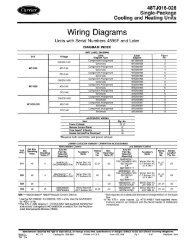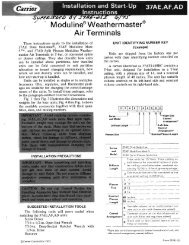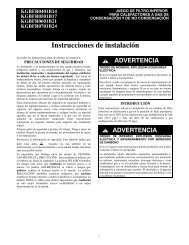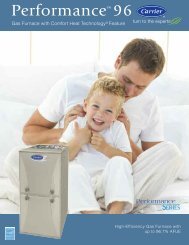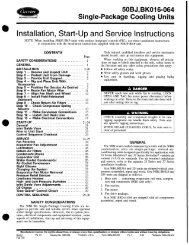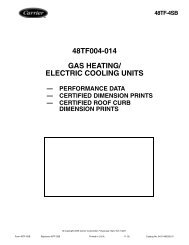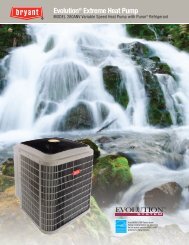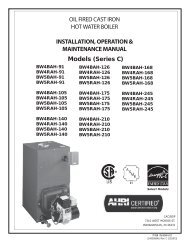Start-Up, Operation, and Maintenance Instructions
Start-Up, Operation, and Maintenance Instructions
Start-Up, Operation, and Maintenance Instructions
You also want an ePaper? Increase the reach of your titles
YUMPU automatically turns print PDFs into web optimized ePapers that Google loves.
TRANSFER REFRIGERANT FROM CHILLER TO PUMP-<br />
OUT STORAGE TANK<br />
1. Equalize refrigerant pressure.<br />
a. Valve positions:<br />
VALVE 1a 1b 2 3 4 5 6 7 8 10 11 12 13 14<br />
CONDITION C C C C C<br />
b. Slowly open valve 5. When the pressures are<br />
equalized, open liquid line valve 7 to allow liquid<br />
refrigerant to drain by gravity into the pumpout<br />
storage tank.<br />
VALVE 1a 1b 2 3 4 5 6 7 8 10 11 12 13 14<br />
CONDITION C C C<br />
2. Transfer the remaining liquid.<br />
a. Turn off the pumpout condenser water. Place the<br />
valves in the following positions:<br />
VALVE 1a 1b 2 3 4 5 6 7 8 10 11 12 13 14<br />
CONDITION C C C<br />
b. Run the pumpout compressor for approximately<br />
30 minutes; then close valve 10.<br />
VALVE 1a 1b 2 3 4 5 6 7 8 10 11 12 13 14<br />
CONDITION C C C C<br />
c. Turn off the pumpout compressor.<br />
3. Remove any remaining refrigerant.<br />
a. Turn on the chiller water pumps using the PUMP-<br />
DOWN LOCKOUT screen, accessed from the<br />
CONTROL TEST table. Turn on the pumps manually,<br />
if they are not controlled by the PIC II.<br />
b. Turn on the pumpout condenser water.<br />
c. Place valves in the following positions:<br />
VALVE 1a 1b 2 3 4 5 6 7 8 10 11 12 13 14<br />
CONDITION C C C C<br />
d. Run the pumpout compressor until the chiller pressure<br />
reaches 30 psig (207 kPa) for HFC-134a.<br />
Then, shut off the pumpout compressor. Warm<br />
condenser water will boil off any entrapped liquid<br />
refrigerant <strong>and</strong> the chiller pressure will rise.<br />
e. When the pressure rises to 40 psig (276 kPa) for<br />
HFC-134a, turn on the pumpout compressor until<br />
the pressure again reaches 30 psig (207 kPa), <strong>and</strong><br />
then turn off the pumpout compressor. Repeat this<br />
process until the pressure no longer rises. Then,<br />
turn on the pumpout compressor <strong>and</strong> pump until<br />
the pressure reaches18 in. Hg. (40 kPa absolute).<br />
f. Close valves 1a, 1b, 3, 4, 6, 7, <strong>and</strong> 10.<br />
VALVE 1a 1b 2 3 4 5 6 7 8 10 11 12 13 14<br />
CONDITION C C C C C C C C C C<br />
g. Turn off the pumpout condenser water <strong>and</strong> continue<br />
to use the PIC II PUMPDOWN LOCKOUT<br />
screen functions, which lock out the chiller compressor<br />
for operation.<br />
4. Establish a vacuum for service.<br />
To conserve refrigerant, operate the pumpout compressor<br />
until the chiller pressure is reduced to 18 in. Hg vac., ref<br />
30 in. bar. (40 kPa abs.) following Step 3e.<br />
70<br />
Chillers with Isolation Valves<br />
TRANSFER ALL REFRIGERANT TO CHILLER CON-<br />
DENSER VESSEL — For chillers with isolation valves,<br />
refrigerant can be stored in one chiller vessel or the other without<br />
the need for an external storage tank.<br />
1. Push refrigerant into the chiller condenser.<br />
a. Valve positions:<br />
VALVE 1a 1b 2 3 4 5 8 11 12 13 14<br />
CONDITION C C C C C C<br />
b. Using the PIC II controls, turn off the chiller water<br />
pumps <strong>and</strong> pumpout condenser water. If the chiller<br />
water pumps are not controlled through the PIC II,<br />
turn them off manually.<br />
c. Turn on the pumpout compressor to push the liquid<br />
refrigerant out of the chiller cooler vessel.<br />
d. When all liquid refrigerant has been pushed into<br />
the chiller condenser vessel, close chiller isolation<br />
valve 11.<br />
e. Access the PUMPDOWN LOCKOUT screen on<br />
the PIC II CONTROL TEST table to turn on the<br />
chiller water pumps. If the chiller water pumps<br />
are not controlled by the PIC II, turn them on<br />
manually.<br />
f. Turn off the pumpout compressor.<br />
2. Evacuate the refrigerant gas from chiller cooler vessel.<br />
a. Close pumpout compressor valves 2 <strong>and</strong> 5, <strong>and</strong><br />
open valves 3 <strong>and</strong> 4.<br />
VALVE 1a 1b 2 3 4 5 8 11 12 13 14<br />
CONDITION C C C C C C C<br />
b. Turn on the pumpout condenser water.<br />
c. Run the pumpout compressor until the chiller<br />
cooler vessel pressure reaches 18 in. Hg vac<br />
(40 kPa abs.). Monitor pressures on the CVC/<br />
ICVC <strong>and</strong> on refrigerant gages.<br />
d. Close valve 1a.<br />
e. Turn off the pumpout compressor.<br />
f. Close valves 1b, 3, <strong>and</strong> 4.<br />
VALVE 1a 1b 2 3 4 5 8 11 12 13 14<br />
CONDITION C C C C C C C C C C C<br />
g. Turn off the pumpout condenser water.<br />
h. Proceed to the PUMPDOWN/LOCKOUT function<br />
accessed from the CONTROL TEST table to turn<br />
off the chiller water pumps <strong>and</strong> lock out the chiller<br />
compressor. Turn off the chiller water pumps manually<br />
if they are not controlled by the PIC II.<br />
TRANSFER ALL REFRIGERANT TO CHILLER<br />
COOLER VESSEL<br />
1. Push the refrigerant into the chiller cooler vessel.<br />
a. Valve positions:<br />
VALVE 1a 1b 2 3 4 5 8 11 12 13 14<br />
CONDITION C C C C C C<br />
b. Turn off the chiller water pumps (either through<br />
the PIC II controls or manually, if necessary) <strong>and</strong><br />
the pumpout condenser water.<br />
c. Turn on the pumpout compressor to push the<br />
refrigerant out of the chiller condenser.<br />
d. When all liquid refrigerant is out of the chiller condenser,<br />
close the cooler isolation valve 11.<br />
e. Turn off the pumpout compressor.







